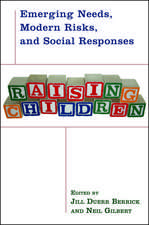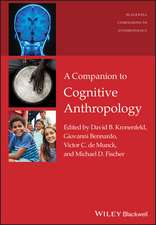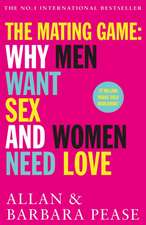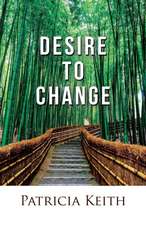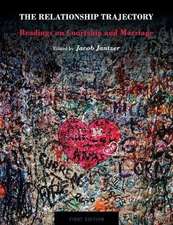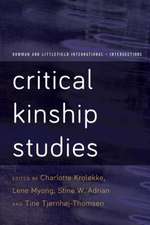Why Men Want Sex and Women Need Love: Unravelling the Simple Truth
Autor Barbara Pease, Allan Peaseen Limba Engleză Paperback – 31 dec 2009
Will men and women ever see eye-to-eye about love and sex? How will relationships ever be rewarding if men only want to rush into bed and women want to rush to the altar? In this practical, witty and down-to-earth guide, couples experts Allan and Barbara Pease reveal the truth about how men and women can really get along. By translating science and cutting edge research into a powerful yet highly entertaining read, you’ll learn how to find true happiness and compatibility with the opposite sex.
REVEALED IN THIS BOOK:
* The seven types of love
* The top five things women want from men
* What to do when the chemistry is wrong
* What turns men and women on ߝ and off!
* The most common “New Relationship” mistakes and how to avoid them
* How to decode “manspeak”
If you want to get the most satisfaction from your relationship, or are single and looking for the right person, then you must read this book for the answer to Why Men Want Sex and Women Need Love.
Preț: 106.64 lei
Nou
20.41€ • 21.23$ • 16.85£
Carte disponibilă
Livrare economică 22 martie-05 aprilie
Specificații
ISBN-10: 030759159X
Pagini: 265
Dimensiuni: 132 x 205 x 20 mm
Greutate: 0.23 kg
Editura: BROADWAY BOOKS
Notă biografică
ALLAN and BARBARA PEASE are the most successful relationship
authors in the business. They have written a total of 15 bestsellers ߝ
including 9 number ones ߝ and give seminars in up to 30
countries each year. Their books are available in over 100
countries, are translated into 51 languages and have sold over
25 million copies. They appear regularly in the media worldwide
and their work has been the subject of 9 television series, a stage
play and a No.1 box office movie which attracted a combined
audience of over 100 million.
Extras
Sex on the Brain
Passion, infatuation, romance, "the hots," obsessive love, beer goggles . . . these are the words we use to describe those feelings of ecstasy, elation, bliss, and rapture that almost all people will experience in some way at some time in their lives.With them come the feelings of anguish, distress, pain, agony, torment, and grief. For thousands of years, experts have tried, with little success, to define romantic love, usually concluding that it must be controlled somehow by forces outside ourselves, suchas the mystical, supernatural, or spiritual. Yet we have no difficulty in pigeonholing other human emotions, like depression, anxiety, obsession, and fear.
Since the 1970s, humans have experienced a deep spiritual yearning for love. This yearning is caused by the breakdown of the social structures that gave us intimate connections with friends, family, and lovers and was the norm for thousands of years. Weevolved as a species that cared for our young; protected, loved, and depended on each other; and stuck together as social and family units. The older generations cared for the children, while the middle generation worked or collected food. In the evenings,the older generations told children stories and taught them about their heritage and about life. This kind of family structure now exists only in primitive cultures, parts of the Middle East, Asia, the Mediterranean, and Third World cultures. And as more andmore people are staying single or living alone, this cultural chasm continues to widen. For a million years or more, societies have been structured to bring men and women together; today's societies, however, are driving them apart. The erosion of the basicfamily structure has led to loss of values, kids growing up without fathers, and emotional chaos.
Same Goals, Different Agendas
Men and women have very different agendas when it comes to sex and love, and these are deeply embedded in our ancient past. In basic terms, today's men are turned on by visual images and by the signs of a woman's health, fertility, and youth, where aswomen are turned on by the markers of a man's power, status, commitment, and material resources--just as their ancestors were. In fact, nothing much has really changed for hundreds of thousands of years in terms of our sexual urges and drives. This can be anunpopular idea in a politically correct world in which it has become fashionable to say that men and women want the same things in life and have the same motivations, preferences, and urges, but as you read on, you will see that this is simply not true. Infact, deep down you know it's not. This myth is perpetuated by powerseekers such as bureaucrats, church leaders, feminist groups, and other politically motivated individuals. It may be politically correct to say that men and women think the same way and wantthe same things, but if you have had any experience living with them, working with them, or managing them, you'll know that it isn't true.
The Power of Love
David Buss, professor of psychology at the University of Texas at Austin, is internationally recognized for his evolutionary research on human sex differences in mate selection. He and his team searched for evidence of romantic love in 147 cultures. Theydiscovered empirical proof of romantic love in cave drawings, manuscripts, poems, songs, and books. Most people see only the positive sides of love when they think about it--they imagine staring into a lover's eyes, holding hands, singing love songs, makinglove, and warm, fuzzy feelings, all the "happily-ever-after" stuff--but love also has a dark side. Buss and other researchers found evidence spread throughout human history of love potions, love charms, love spells, suicide, and murder motivated by love wonor lost. In fact, one in four murders is the result of love gone wrong. Spouses, lovers, rivals, stalkers, and jilted lovers everywhere die as a result. Almost every culture has its equivalent of the Romeo and Juliet story. The dramatic urge to love fills uswith exhilaration, despair, fear, or revenge, often all at the same time.
And because romantic love is universal and every human culture on earth has it, there must be a biological basis for it. In other words, it can't simply be a cultural tradition, like idol worship or religion; love is something that is very powerful andis hardwired into each of us.
The Biology of Love
Scientists who have been researching how the human brain operates when a person is in love have concluded that there are three distinct brain systems for mating and reproduction--lust, romantic love, and long-term attachment.
Each of these systems is associated with distinct hormone activity that cause specific feelings and behavioral changes in lovers. When you think of love in terms of these three systems, it makes it easier to follow what stage a person is in and to betterunderstand that person's actions.
The purpose of this chapter is to help you understand the basic brain functions that govern lust, romantic love, and long term attachment. We have attempted to keep the explanations as brief and simple as possible. Where we talk about specific areas ofthe brain, it's important to understand that the brain regions discussed are usually part of an overall brain network, and we thank Professor Graeme Jackson of the Brain Research Institute in Melbourne for his suggestions in this area. We have simplified thingshere to make them more accessible to our readers; at the same time, we are conscious of not oversimplifying these ideas and concepts. It is vital to have this knowledge of the research because it's referred to throughout this book. We use medical terminologyfor the technically inclined, but you will only need to understand its significance in relation to your love life. We will be discussing principles that operate most of the time for most people, not how minorities or the exceptions behave.
Love has been shown to be the result of a specific group of chemicals and brain circuits working in specific areas of the brain. In simple scientific terms, love is triggered by a combination of brain chemicals, including dopamine, oxytocin, testosterone,estrogen, and norepinephrine; in much the same way, these chemicals drive other mammals to find suitable partners. Once our brain has identified a suitable partner based on certain criteria, which are discussed later, the brain goes into overdrive to producethe chemicals necessary to create the environment to attract that person.
Throughout human history, marriages were an arranged event based on wealth, status, family rivalries, tribal groups, and politics. Today, this approach has generally disappeared from the Western world and most people now marry for love.
When it comes to mate selection, humans focus their attention on just one person. This distinguishes them from most other animals. A courting male pigeon, for example, will puff up his feathers and approach as many potential partners as his energy willallow. Humans, however, usually have a short list of candidates but intensely target just one.
Love at First Sight
The phenomenon of "love at first sight" has been scientifically proved and affects most animal species in much the same way.
Ray was shopping in the supermarket when he glanced between the cornflake packets into the candy aisle. What he saw overwhelmed him, and he experienced a euphoric feeling, almost as if he was intoxicated. Standing there was a woman who simply capturedhis heart. She was not beautiful in the usual sense, but there was something unique about her and the way she moved. All he knew was that he felt magnetically drawn to her. Just looking at her filled him with excitement and gave him butterflies in his stomach.
While he experienced these feelings of elation at discovering her, however, he had at the same time a sense of despair because he would never have her.
If you've ever experienced love at first sight, your brain was producing huge amounts of the chemicals dopamine and norepinephrine, which make you feel almost as if you are on drugs. The same things happen to other animals. Take, for example, the femaleprairie vole, which is similar to a desert rat. If you expose a female prairie vole to even a tiny scent of male vole urine, she experiences exactly the same chemical reaction humans do: a surge of dopamine and norepinephrine. One study demonstrated that whenfemale sheep that are in heat are shown images of male sheep, norepinephrine levels in their brains surge. Although this effect lasts for seconds or minutes for most animals, it can last for months or years in humans.
Scientists now agree that love at first sight is a real phenomenon. Scientists working in this area also believe that in a stable society in which people are not under the threat of death or war, lust, romantic love, and long-term attachment may be thebest and most efficient way to ensure species survival.
Darwin Made Me Do It
Lust is brought on by surges in sex hormones such as testosterone and estrogen. These hormones cause an urgent push for physical gratification. During lust, two key parts of the brain become active--the hypothalamus, which controls our primordial drives,such as thirst and hunger, and the amygdala, which is a center for arousal. Dopamine is secreted heavily during lust, and it triggers the production of testosterone, causing sexual attraction to occur. It happens when you first see someone and have an overwhelmingurge to "have" that person.
A study conducted in 2006 at the University of Chicago demonstrated that even during a casual chat with a female stranger testosterone levels shoot up by a third in men and that the stronger this hormonal reaction, the more dramatic the changes in a man'sbehavior. The study also showed testosterone readings in married men and fathers are significantly lower than in single males who are "playing the field" because the fathers have moved into a nurturing, parental role and have higher oxytocin levels than singlemen, who are still searching for somewhere to pass on their genes.
Lust obviously evolved to lead to procreation and to ensure the survival of the human species and would have been necessary in extremely difficult survival circumstances when there was no time for romance. Also, human females can bear only one offspringa year, which means that without lust, the human species could be threatened with extinction--because we are slow reproducers, Mother Nature made us enthusiastic procreators. This is why people in dangerous and threatening situations, such as wartime, can suddenlyfind themselves lusting after each other even though they are strangers. If their lives are in danger, they have the immediate urge to pass on their genes.
In summary, lust, love at first sight, and the obsessive, goaldriven aspects of early love are behaviors that evolved to speed up mating and provide a better chance for successful human reproduction.
Let's Stick Together
Testosterone is the main hormone responsible for the sex drive, and men have ten to twenty times more of it than women. This is why the male sex drive is strong and so urgent. Testosterone makes men hairier, bigger, stronger, more aggressive, and hornierthan women. But men have significantly less oxytocin than women. Oxytocin, known as the "cuddle hormone," is released in large quantities in men and women during orgasm. As quickly as a man can get an erection, his oxytocin dissipates, which is the reason whyafter-sex cuddles have great importance to women and limited appeal to men.
A study in 2006 by Rebecca Turner, Ph.D., professor in the Organizational Psychology Division of Alliant International University in San Francisco, showed that this hormone is the glue of human emotional bonding. When people are pairbonding--or "fallingin love," as we call it--oxytocin levels are high. This is the hormone that gives us the warm, fuzzy feeling we have for the person of our desire. Having higher levels of oxytocin than men is a major reason why women fall more deeply in love at the start ofa new relationship than men do. The more oxytocin they produce, the more nurturing they will be and the more deeply they will bond with someone. Just hearing their lover's name, an odor associated with him, fantasizing about him, or hearing a song connectedwith him raises oxytocin levels. Expensive outfits, perfect makeup, loads of jewelry, and a new sports car cannot disguise a woman's emotional condition. If she feels loved and adored, her hormones push blood into her cheeks, making her "glow," and she willradiate warmth. If she feels unloved and ignored, however, that's easy to see, too.
The studies by David Buss showed that when couples are in the falling-in-love phase, men's testosterone levels decrease and their oxytocin levels rise to make the bonding process quicker. This makes men softer, gentler, and more easygoing. At the sametime, women's testosterone levels rise with the excitement and confidence they feel at the start of a new relationship. This increased testosterone makes women hornier, giving the couple the illusion that male and female sex drives must be the same. When this"shagathon" period ends, about three to nine months into a new relationship, their sex drives return to the "default position," leaving a man with the idea that she's gone off sex and giving her the impression that he's a sex maniac. Many relationships end at this point.
Descriere
Allan and Barbara Pease, the international bestselling authors of Why Men Don’t Listen & Women Can’t Read Maps, deliver their most exciting book yet.
Will men and women ever see eye-to-eye about love and sex? How will relationships ever be rewarding if men only want to rush into bed and women want to rush to the altar? In this practical, witty and down-to-earth guide, couples experts Allan and Barbara Pease reveal the truth about how men and women can really get along. By translating science and cutting edge research into a powerful yet highly entertaining read, you’ll learn how to find true happiness and compatibility with the opposite sex.
REVEALED IN THIS BOOK:
* The seven types of love
* The top five things women want from men
* What to do when the chemistry is wrong
* What turns men and women on ߝ and off!
* The most common “New Relationship” mistakes and how to avoid them
* How to decode “manspeak”
If you want to get the most satisfaction from your relationship, or are single and looking for the right person, then you must read this book for the answer to Why Men Want Sex and Women Need Love.

